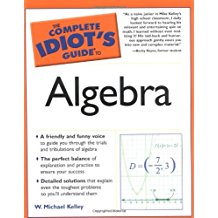Algebra: Standard Form of a Line
Standard Form of a Line
As long as you keep an equation balanced, you can do just about anything to both of its sides to change the way it looks. For example, take a look at these two linear equations:
- 3x - 2y = 4 and 1 + 12y = 34x
They may not look anything alike, but they are equivalent! In case you don't believe me, I'll prove it to you. I'll start with the right-hand equation and play with it until it looks exactly like the left-hand equation. To start, I'll multiply both of its sides by 4.
- 4 + 42y = 124x
- 4 + 2y = 3x
How'd You Do That?
I usually write fractional coefficients like this: 13y. However, you could also write the same quantity as y3, and the value would be the same. Why? Technically, you can give the variable a denominator of 1 and multiply fractions: 13 · y1 = y · 13 · 1 = y3.
Now, I'll flip-flop the sides of the equation, which is allowed according to the symmetric property.
- 3x = 4 + 2y
Finally, I'll subtract 2y from both sides and the transformation is complete.
- 3x - 2y = 4
Isn't that much better-looking than 1 + 12y = 34x? Most math teachers think so. In fact, they feel so strongly about it that they usually require you to write your answers in the tamer, less-fractiony version on quizzes and tests.
Talk the Talk
An equation in standard form looks like ax + by = c, where b and c are integers, and a is a positive integer.
This prettier version of the equation is called standard form, and it has the following properties:
Talk the Talk
If a linear equation is in standard form ax + by = c, you can use the shortcut formula m = -ab to find the slope. For example, the slope of 5x - 8y = -2 will m = - (5-8) = 58
- An equation in standard form looks like ax + by = c; in other words, the x and y terms are on the left side of the equation and the constant is on the right side.
- The constant and both of the coefficients must be integers.
- The coefficient of the x-term must be positive.
Why bother putting equations in standard form? To be honest, I'm not sure why teachers stress this so much. I much prefer slope-intercept form, since its values m and b actually represent something, whereas the coefficients of standard form really have no practical meaning.
Some say that standard form is important since every known linear equation can be put into standard form, but vertical lines (like x = 2) cannot be put in slope-intercept form. (Remember, slope-intercept form means solving for y, and if there's no y around, that's impossible.) Maybe that's true, but in my opinion, standard form is preferred because people hate fractionseven your algebra teacher, although she'd never admit it.
Example 4: Put the linear equation -23 -4x = 59y in standard form.
Solution: The first order of business is to get rid of all those ugly fractions. Take a look at the denominators in the equation (3 and 9) and calculate the least common denominator.
In this case, the least common denominator is 9, so multiply both sides of the equation by 9 written as a fraction (91):
Kelley's Cautions
Remember, only the x-term has to be positive in standard form, not the y-term or the constant. As you see in Example 4, changing the sign of the x-term (when necessary) will often result in one or more of the other terms becoming negative, and that's okay.
You've Got Problems
Problem 4: Put the linear equation 54y = 73 + 16x in standard form.
- -183 - 361x = 459y
- -6 - 36x = 5y
Move 5y to the left side of the equation by subtracting it from both sides. Also add 6 to both sides, so the constant ends up on the right side of the equation.
- -36x - 5y = 6
Remember, the x-term has to be positive in order for the equation to be in standard form, but right now it's not. No sweatjust multiply both sides of the equation by -1.
- 36x + 5y = -6

Excerpted from The Complete Idiot's Guide to Algebra © 2004 by W. Michael Kelley. All rights reserved including the right of reproduction in whole or in part in any form. Used by arrangement with Alpha Books, a member of Penguin Group (USA) Inc.
You can purchase this book at Amazon.com and Barnes & Noble.







